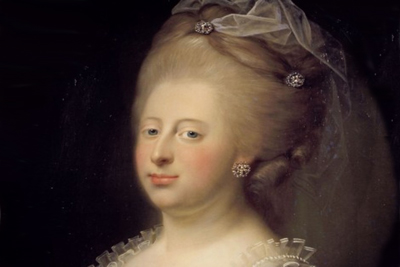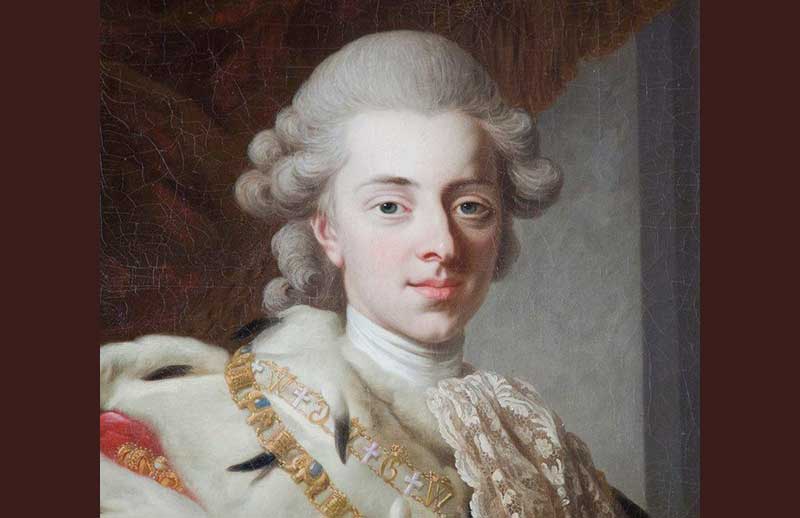
Born in July 1751, as the ninth and youngest child of Fredrick, Prince of Wales and Princess Augusta, Princess Caroline Mathilde lost her father suddenly, about three months before her birth, and was brought up by her strict mother away from the English court and was described as natural and informal. While she lived with her family in Leicester House, during the holidays they moved to the Kew Palace, where she enjoyed riding and loved the outdoor life. Despite the irregularities of her and her sisters' education, Caroline could speak three European languages, which included French, Italian and German. She also had a gifted sweet voice and was an accomplished singer.
On 10 January 1765, Caroline Mathilde was officially engaged to her first cousin, Crown Prince Christian of Denmark, as the marriage was considered suitable because the British and Danish royal families were both Protestant and of the same rank. However, in the middle of preparation for the wedding, King Fredrick of Denmark died on 14 January 1766, and his 17-year-old son became King Christian VII. Under the changed circumstances, the royal couple was married by proxy on 1 October 1766, in the royal chapel of St James’ Palace, when the groom was represented by Prince Edward, the second son of Fredrick, Prince of Wales, and Princess Augusta. After that, Carolina was sent to Denmark, where she was married to King Christian VII in person on 8 November 1766 in the Royal Chapel at Christiansborg Palace in Copenhagen. After nearly a month after the marriage, Caroline Matilda was crowned Queen of Denmark in Copenhagen on 1 May 1767.

However, the marriage was unhappy from the start, as her husband was said to be mentally unstable and had exhibited strange symptoms even as a child. He was resentful, as he was forced to marry by his court, who believed that marriage would lead to an improvement in his mental problems. King Christian VII did not like his wife, even refused to consummate the marriage for months, and despite the rumours of homosexuality, he had a mistress with whom he began a relationship in Holstein in the summer of 1766. Apart from that, he often visited the courtesans in Copenhagen, of which the most famous was Anna Katrina Bentgagen.
At the same time, the young queen at the Danish court was described as charming, vivid, and temperamental, too plump to be depicted as a beauty. Her natural vivacious and unaffected personality was not really popular at the strict Danish court. Gradually, Caroline became close to her lady-in-waiting, Louise von Plessen, who disliked the king’s intimate friends as immoral and tried to isolate the queen from her husband. Even, she advised Caroline Mathilde to feign to be indisposed when the King expressed his wish for physical intimacy as she thought that elusiveness would make the King more eager. Instead, it only made him more cold and unwilling. Finally, after being persuaded by his old tutor Reverdil, King Christian VII consummated his marriage for the sake of the succession. Nevertheless, after the Queen gave birth to the Crown Prince Fredrick on 28 January 1768, the king returned to his old habits with renewed interest in the brothels of Copenhagen.

Caroline Mathilde felt further neglected and spurned, when in 1768, Conrad Holck, one of the favourites of her husband, managed to exile Louise von Plessen, her favourite lady-in-waiting, from the court, leaving the Queen even more isolated. She refused to accept Plessen's proposed successor, as she suspected that the lady had taken part in the plot to exile Plessen. Eventually, she accepted the second choice, when Margrethe von Luhe agreed to be her lady-in-waiting.
In May 1768, when Christian VII took a long tour of Europe, Caroline Mathilde took care of her son and scandalized the nobles, as she took walks in Copenhagen, when it was usual for the royal and noble Danish women to travel in town only by carriages. There were also rumours that during that period of the absence of the king, the queen had an affair with La Tour, a handsome actor and a singer from the French-language theatre. Despite the actor was said to be the lover of her the then lady-in-waiting Elisabet von Eyben, his visits to von Eyben's chamber were in fact visits to the chamber of the Queen. Though there was no substantial evidence of the affair, the king exiled La Tour on his return, perhaps due to its damaging result on his image. Apart from her intimate relationship with von Eyben, Caroline Mathilde made warm friendship with several other ladies of doubtful reputation, like Anna Sofie Bulow, Amalie Sofie Holstein, and Christine Sophie Hahler, well-known for their love affairs, who encouraged her immoral activities, like participating more aggressively in social life, dance, and flirt with attractive young men.

King Christian VII returned from his European sojourn on 12 January 1769, along with his newly appointed Royal Physician, the German doctor, Johann Friedrich Struensee, who aptly managed the highly unstable mental condition of the king while he was in Altona in Germany. The thirty-year-old Struensee was a tall and handsome man, but initially, Caroline disliked him as he encouraged the King to take a new mistress, Birgitte Sofie Gabel, reportedly because he believed a relationship with an intelligent, polished, smart, and astute woman would make the King more mentally stable. As his attempt failed miserably, Struensee encouraged the King to improve his relationship with his wife, Caroline Mathilde. The king, in his turn, showed his interest to his wife as he arranged a three-day birthday party in her honour on 22 July 1769. As the Queen was well aware of his contribution in the matter, interest in the charming doctor started to develop in her. Later, in the summer of 1769, when Caroline Mathilde had an attack of dropsy, he helped her to come out of the problem with his simple prescription of entertainment and exercise. Struensee also gained credibility with her, when he successfully inoculated the Crown Prince against smallpox. In January 1770, Struensee was provided with his own rooms at Christiansborg Palace and by the spring of 1770, he became the lover of the Queen. While the German doctor never dreamt to be the lover of a queen, the restless and unhappy soul of the vivacious young queen found love and solace in a man who was not her husband.

During the following months, Caroline caused a further scandal as discarding her sidesaddle, she donned riding breeches and rode on a saddle designed for a man and went on long rides in North Zealand’s forests, accompanied by none other than the Royal Physician Johann Struensee. During their ride, they would spend the day in the forests near the Hermitage Royal Hunting Lodge, and at night Struensee would steal into the bedroom of Queen Caroline Mathilde.
Working together, Caroline and Struensee banished the malicious favourites of the king from the court, as the king became more and more whimsical and unworldly and signed everything that his physician put in front of him. In September 1770, Struensee was appointed privy counselor, and as the king sank into a condition of mental torpor, he held absolute power for the next ten months, beginning from 20 March 1771. Virtually armed with unlimited power, Struensee issued no fewer than 1069 cabinet orders, or more than three a day, and introduced freedom of speech, abolished torture and capital punishment for theft, abolished several holidays and dismissed the Royal Guard.
In the meantime, the Queen’s affair with Struensee offended the nation that had traditional respect for the royal house and brought the Crown into contempt as the couple reportedly made little attempt to hide their affair. Their affair alienated the clergy and the Danish nobility, who complained the matter to King Christian’s stepmother, the Dowager Queen Juliana. In the following months, Caroline's support for her lover's attempts to reform the country led to her extreme unpopularity among the conservative circles at court. However, as the Dowager Queen Juliana led the opposition party at court, Caroline formed her own group of followers.
On 17 June 1771, Queen Caroline Mathilde took up her summer residence at Hirschholm Palace, where she gave birth to her second child on 7 July 1771. Although there was little doubt about the paternity of the baby, she was named Princess Louise Augusta. However, by the end of 1771, the lovers began to suspect that the Dowager Queen Juliana Maria has hatched a plot against them, and they returned to Copenhagen on 8 January 1772.

By that time, Struensee and Caroline Mathilde were already in danger as rumours circulated at the court that Caroline and her lover have planned to overthrow King Christian from power and rule the country themselves. After another courtier gave fake evidence to the Dowager Queen to the effect that the couple was plotting against the King, details of the case were specified on 15 January at the Dowager's residence, and the execution of the conspiracy was scheduled for the night between 16 and 17 January. Accordingly, Carolina Mathilde and Johann Friedrich Struensee were arrested in the middle of the night between 16 and 17 January. While Caroline moved to the Kronborg Castle with her baby daughter, the four-year-old Crown Prince Fredrick remained with his father. Later, the Queen reported to the court that on the evening of 17 January, she saw from the windows of her chamber the festive illuminations for the celebration of her fall from the grace in Copenhagen.
Meanwhile, Struensee was subjected to torture, and after being informed that Caroline Mathilde had been arrested, and confessed about their alleged affair, he confessed to being the Queen's lover. On the other hand, while Caroline initially denied her relationship with Struensee, she is said to have been manipulated to admit the relationship on a later date and signed a confession with the hope that Struensee's life might thereby be spared. However, following the divorce of Caroline Mathilde and Christian VII on 6 April 1772, Struensee and his accomplice Count Enevold Brandt were executed on 28 April 1772, while Caroline Mathilde was imprisoned in the Kronborg Castle, Elsinore.

During the same year, Mathilde’s older brother, King George III, sent a British diplomat, Sir Robert Murray Keith, to negotiate his sister's release from imprisonment, when it was agreed that Denmark would provide her a pension, return her dowry, and she would be able to retain her title. On 3 May, she left Kronborg Castle and was deported on board a British frigate, leaving behind her children in Denmark, whom she never saw
again in her life. As George III was shocked by his sister's conduct, he did not receive her at the English court and sent her to Celle Castle in Hanover. There, in the castle, she was reunited with her friend and former lady-in-waiting Louise von Plessen and was occasionally visited by friends and family, including her sister Augusta.

She intended to return Denmark to act as the Regent of her minor son, and in 1774, she wrote to her brother, King George III, requesting his support in the matter. But it all ended on 10 May 1775, when Caroline Mathilde suddenly died of scarlet fever at Celle, at the early age of just 23. She was buried in the Stadtkirche St Marien in Celle, near her great-grandmother, Sophia Dorothea, another woman exiled from her court and children.
